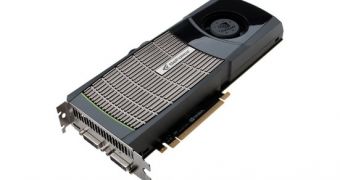Officially, NVIDIA's GeForce GTX 480 and GTX 470 graphics cards are selling, but it seems that availability is not what it should be. In fact, Fermi-based graphics adapters can barely be found available for order and, when they do get listed, they have prices far above the $499 that the GPU maker intended. End-users that have been keeping track of the DirectX 11-capable NVIDIA graphics saga will likely suspect the reason behind this, but, for those that do not (or want a confirmation), financial analysts from Needham and Company have looked into the matter.
Apparently, even though NVIDIA reduced the number of stream processors by 32 on the GTX 480, hoping to reach a better supply, the Santa Clara GPU maker still can't put together enough adapters because it only has about ten thousand GF100 GPUs on the market. This is, as always, due to TSMC's low yields of 40nm chips. If this situation persists, NVIDIA will not only be unable to ramp up production of GeForce GTX 400 cards, but it will also be unable to make sufficient Tesla C2000 Series products when the time comes.
“We are downgrading Nvidia to a ‘hold’ and removing our 12-month price target (was $22) after a series of channel checks indicating that Fermi is not ramping well and there could be further product delays. Based on our findings, Nvidia has very limited supply of Fermi desktop/notebook parts and yields remain poor at around 20-30%,” analyst Rajvindra Gill wrote in a note to clients.
Short supply has already impacted upon sales and will continue to do so until 40nm yields improve. Still, while this is misfortune enough, NVIDIA has another disadvantage, in that its GTX 480 wasn't able to overcome the performance of the Radeon HD 5970. This means that the so-called Halo Effect caused by the hype built around Fermi may not outlast inventory shortages (because the GTX 480 simply is not the strongest out there), which will ultimately lead to much lower sales and, thus, more design wins for AMD. That said, a reduction in NVIDIA's market share is the most probable outcome.
“We believe Nvidia could lose market share starting in [the second half of 2010], face a more challenging pricing environment and/or experience potentially lower gross margins,” the analyst added.

 14 DAY TRIAL //
14 DAY TRIAL //